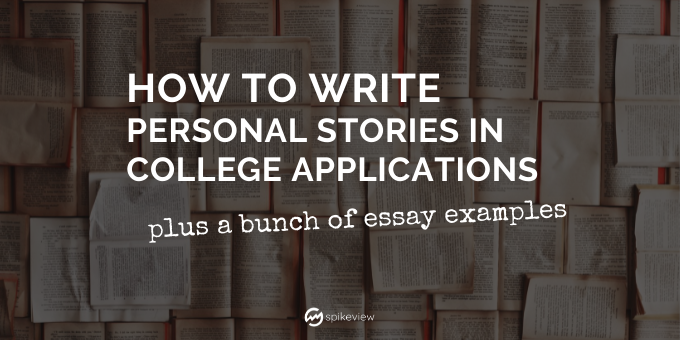How to write personal stories in college application essays (plus a bunch of examples)
Your college essay should pack a punch, or you shouldn’t pack your bags.
College application essays might as well be titled “Tell me about yourself.” This is your chance to show why you and the school are a great fit for each other. Many high schoolers freeze with anxiety at the thought of proving themselves unique.
How on earth can one teenager with average grades and a handful of extracurriculars stand out from the crowd? Tell personal stories and anecdotes! No one else has lived your life.
The answer is easy, but the process takes some practice. It’s especially difficult with most essays having a word limit around 500 words. Let’s get into how to write personal stories in your college essays with some examples to get you motivated.
“Ok applicant, tell me about yourself.”
First of all, let’s remember that college applications are rigorous. They don’t just ask you to list your greatest achievements. They also want to know about your strengths and weaknesses, what you plan to study, and why you’re the best person for the program.
Personal stories take you out of your comfort zone. Your overall application walks the admissions officer through the decision-making process of coming to their college, including why you fit and what you hope to accomplish. Your goal in admissions essays is to make the reader feel as though they really know you, as though they have been there during key moments of your life.
The most crucial aspect of writing personal stories is making them about you. Sounds obvious, but it’s a common mistake. This isn’t the time to quote Shakespeare, Voltaire, or Mother Theresa. Personal stories reflect your own interests, experiences, and quirks.
Context for your essay
Enrollment expert Lori Greene says, “Read the essay questions and/or prompts. Read them again. Then read them one more time.” Understand what’s being asked of you before you start brainstorming anecdotes. Is this essay prompt asking you to inform? Defend? Support? Expand upon?
Once you’re clear on the essay’s prompts, write down some story ideas that demonstrate how you’ve grown from experiences and how you’ll make the school’s community stronger. This exercise will go faster if you’ve already added content to your spikeview profile.
Next, develop a theme that connects your stories. Ethan Sawyer nails it when he says the stories that stand out have an uncommon topic, uncommon connections, and uncommon language.
The right amount of detail
The more details you provide in your stories, the more likely they are to stand out. It’s worth the risk to paint a vivid and unique picture for the reader and then trim off some of the elaborate prose.
Storytelling isn’t just about recounting events and skipping over unnecessary details; it’s about hooking the reader and making them want to know more.
As you craft your story, the “right amount” of detail is subjective. If the scar on your writing hand is a daily reminder of the bicycle crash in your story, then include it. If the shirt you wore makes no difference, then remove it.
How to start a story
Knock their socks off. You’ve got to nail the first sentence. Many schools share examples of essays because they want you to wow them. Check out these opening lines that Stanford University likes to talk about.
Personal stories can take many different forms. Your aim is to make your listeners believe that what you’re saying is true. Don’t start with the part where you were born. The audience is probably wondering how you made the team and about your favorite class. They want to know more about you, not your name.
Avoid bombarding the reader with details, facts and figures, unless they’re relevant to the story. The first thing you want to do is catch their attention. If you want the reader to believe that your story is true, make them curious.
Remember, the big picture is to communicate what you want others to know about you and your learning journey. But please get to the point. There’s no time or space for an epic preamble in your essay.
Make the opening come alive for the reader. Evoke interest. Provoke thought.
How to end a story
End your story with the same mic drop presence as your opening. People remember the start and end of stories, but the middles are lost in memory. Make a clear and compelling conclusion to your theme.
Here’s a great reminder from Chegg.com: Imagine if at the end of a movie, the director chose to restate everything that already took place rather than providing an ending to the story.
12 examples of personal stories on college applications
Here are 12 essays that were part of successful college applications to some prestigious universities. These are intended to give you some ideas for structure and tone. You’ll notice they aren’t perfect, but they were effective in helping the school understand the person behind the paperwork. Use the examples as inspiration for your next college essay.


[…] one of our posts about writing personal essays, we said the more details you provide in your stories, the more likely they are to stand out. […]
[…] college essay should pack a punch, or you shouldn’t pack your bags.Before you get started writing, take some time to think through […]